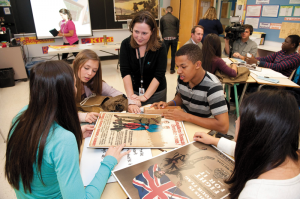Students can “touch” First World War with Discovery Box
By Lookout on Sep 14, 2015 with Comments 0

What weighs 27 kilograms, contains five genuine and 17 reproduction First World War artifacts, including a gas mask and an example of trench art, and can be borrowed without charge by any school in Canada?
It’s the Supply Line First World War Discovery Box created by staff at the Canadian War Museum in Ottawa to give students hands-on experience of what it was like to be First World War soldiers.
Sandra O’Quinn, a learning specialist at the museum, says the idea is to allow students to discover First World War history for themselves.
And, unlike those in many museum exhibits, these artifacts are meant to be touched.
“We chose objects that would stand up to hundreds and hundreds of children handling them,” O’Quinn says.
“We want them to touch, try on and manipulate them.”
Items that are reproductions include the uniform jacket and cap, and the gas mask.
The authentic pieces include the cap badge, shadow boxes with shrapnel and barbed wire, shell casings and an example of trench art.
Trench art was created by soldiers during quiet moments; an example is an intricately engraved mortar shell.
Other items in the box include a gas alarm rattle, which British forces used to warn of chemical attacks, and a trench periscope.
The Discovery Box is modelled on another similar project developed by War Museum staff at its previous location on Sussex Drive.
It was relocated to its current and much larger home on Ottawa’s LeBreton Flats in 2005.
The program was re-launched in September 2014 in recognition of the centenary of the First World War.
Interest from schools was immediate and, in response to positive word of mouth from museum donors and others, more than 200 had signed on to participate before the official launch.
“We’re really happy with it,” says O’Quinn.
“We’re most happy with the teachers’ response.”
She said it was gratifying when teachers reported the tactile approach made it easier to engage students.
She notes the program has proven to be most popular in high schools.
Bilingual lesson plans to go along with the artifacts were developed for students in Grades 4 through 12, although the Discovery Box has also been introduced in classes from Kindergarten to Grade 3.
O’Quinn says a formal lesson plan tailored to that group is available for the 2015-16 school year.
Participating schools can keep the Discovery Box for up to two weeks and can book it once per semester.
For more information and to view the objects online: www.warmuseum.ca/supplyline/about-supply-line.
Lynn Capuano and
Steven Fouchard
Army Public Affairs
Filed Under: Top Stories
About the Author:





